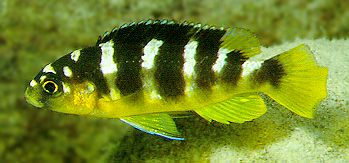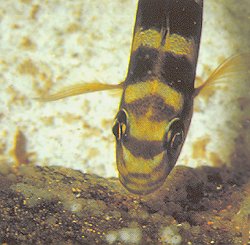

Above: This attractively colored mbuna, often sold to aquarists as the "Bumblebee" or "Hornet" cichlid, is Maylandia crabro, initially described in the genus Melanochromis (Ribbink & Lewis, 1982). The underwater photo was taken by Ad Konings at Cóbuè, Mozambique, and is used here with his generous permission. This species was originally described in the genus Melanochromis, and was once known in the aquarium trade as "Pseudotropheus chamaeleo" (which was, however, only a trade name, never a valid scientific name). It is widely sold as an aquarium fish — although, like most relatives of Maylandia zebra, it is quite aggressive and so not a good choice for the novice cichlid keeper.
The coloration of M. crabro is distinctive. The vertical bars, as shown in the color photographs, are chocolate brown on a golden yellow background (Ribbink & Lewis, 1982). It is a facultative cleaner fish, removing fish lice (Argulus africanus) from the large "Kampango" catfish Bagrus meridionalis. Related fish lice (Argulus jollymani) on cichlids, however, are apparently never eaten. It is thought that the bright, contrasting color pattern may advertise its cleaning services.
 In addition to plucking these ectoparasites from the skin of Bagrus
catfish, M. crabro also eats Bagrus eggs (as shown in the
photo at right by Ad Konings taken at Chinyankwazi Island, Malawi),
which it has been seen to snatch from underneath guarding pairs of the catfish
(Ribbink & Lewis, 1982). But, why would the catfish
continue to allow the brightly colored cichlids to clean it, when the same cichlids
rob its eggs? The answer was discovered by Saulos Mwale, an indigenous
fisherman and keen observer of fish behavior: Mwale reported that the M. crabro
"both conceals its identity and makes itself less conspicuous by quickly changing
colour to dull brown before darting under the guarding male to steal eggs"
(Konings, 1995c: 93). M. crabro also eats
zooplankton, and occasionally phytoplankton, Aufwuchs (epilithic algae), and insects.
In addition to plucking these ectoparasites from the skin of Bagrus
catfish, M. crabro also eats Bagrus eggs (as shown in the
photo at right by Ad Konings taken at Chinyankwazi Island, Malawi),
which it has been seen to snatch from underneath guarding pairs of the catfish
(Ribbink & Lewis, 1982). But, why would the catfish
continue to allow the brightly colored cichlids to clean it, when the same cichlids
rob its eggs? The answer was discovered by Saulos Mwale, an indigenous
fisherman and keen observer of fish behavior: Mwale reported that the M. crabro
"both conceals its identity and makes itself less conspicuous by quickly changing
colour to dull brown before darting under the guarding male to steal eggs"
(Konings, 1995c: 93). M. crabro also eats
zooplankton, and occasionally phytoplankton, Aufwuchs (epilithic algae), and insects.
Below: The holotype of Maylandia crabro
(female, 66.0 mm SL, from Maleri Island; BMNH 1981.11.30.23). Drawing from Fig. 1 of
Ribbink & Lewis (1982).


| Last Update: 22 September 2007
Web Author: M. K. Oliver, Ph.D. Copyright © 1997-2021 by M. K. Oliver, Ph.D. - ALL RIGHTS RESERVED |